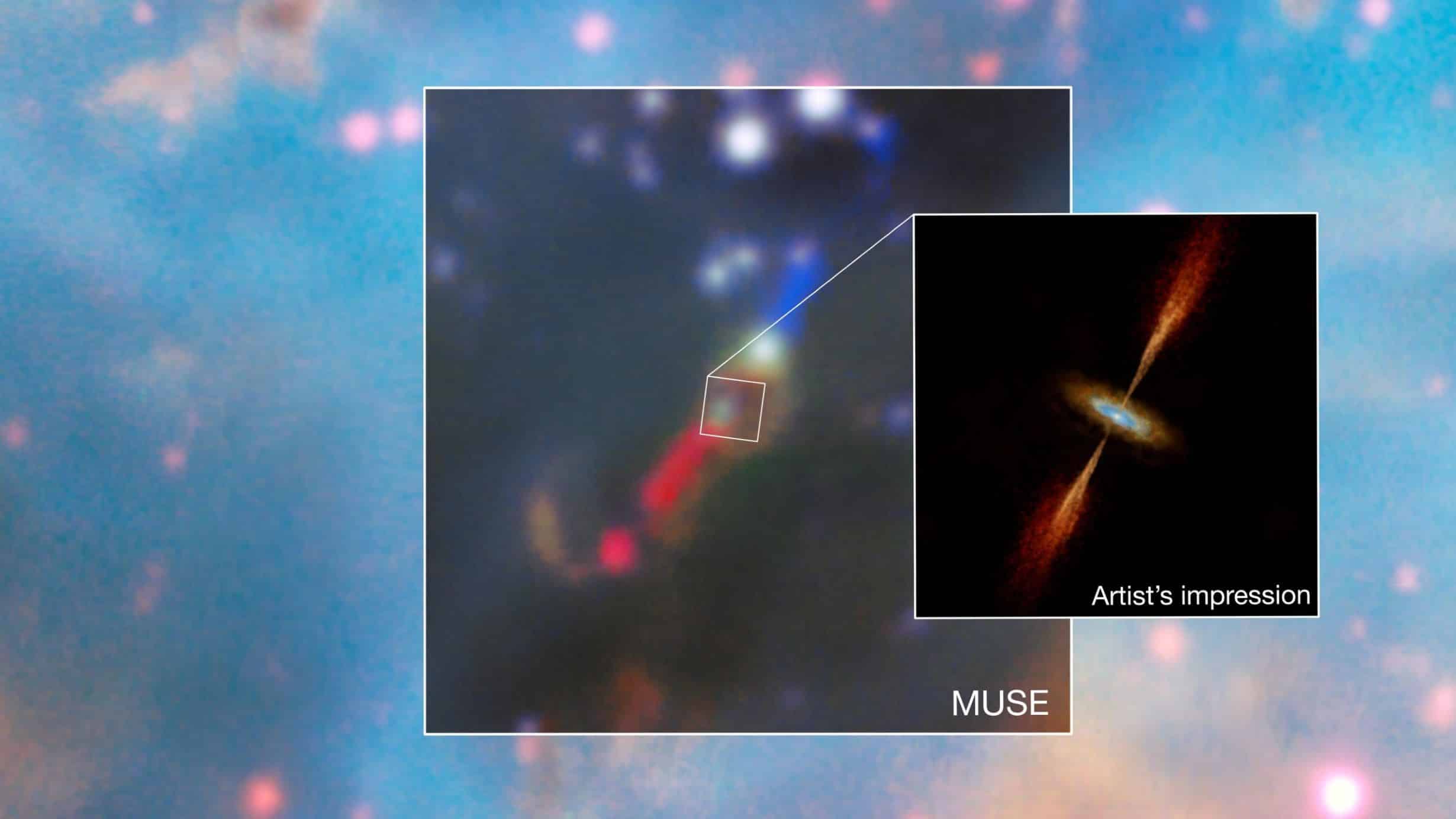⇧ [VIDÉO] You may also like this partner content
For the first time, astronomers have observed a disk of planetary formation around a young star in a galaxy other than the Milky Way. This discovery, made using the Atacama Large Millimeter/submillimeter Array (ALMA) in Chile, is just the starting point for exciting future research into star and planet formation outside our galaxy.
An international team of astronomers led by Durham University’s Department of Physics has discovered a planet-forming disk orbiting a massive young star located in a stellar nursery called N180, in the Large Magellanic Cloud, a neighboring galaxy to the Milky Way. road. An important landmark for astronomy.
In fact, this is the first time that such a disk, identical to those that make up the planets of our galaxy, has been observed outside our galaxy. This observation was made using the Atacama Large Millimeter/submillimeter Array (ALMA), of which the European Southern Observatory (ESO) is a partner, and provides a new perspective on star and planet formation processes in the universe. Details are available in the magazine nature.
Accretion disk, key to the formation of stars and planets
The HH 1177 system represents an exceptional case study for astronomers. The Large Magellanic Cloud, which is located about 160,000 light-years from Earth, provides an opportunity to observe astronomical phenomena similar to those that occur in our galaxy, but in a different context.
The accretion disk discovered around the young star HH 1177 has a structure made up of rotating gas and dust, which plays a key role in the star’s strength and growth. This structure is similar to those observed in the Milky Way, indicating global star and planet formation processes. Anna McLeod, head of this study, announces in A I reported : ” When I first saw evidence of the rotating structure in the ALMA data, I couldn’t believe we had discovered the first extragalactic accretion disk. It was a special moment “.
Initial observations of the HH 1177 system were made using the MUSE instrument mounted on the European Southern Observatory’s (ESO) Very Large Telescope (VLT). These observations revealed the presence of a jet, a stream of material ejected at high speed, emanating from a forming star. These jets are a key indicator of accretion, the process by which a young star attracts and collects material from its environment. The discovery of this jet made it possible to indirectly confirm the existence of the accretion disk.
Multi-Unit Spectroscopic Explorer (MUSE) observations on the VLT, left, show the parent cloud LHA 120-N 180B in which the HH 1177 system was first observed. The picture in the middle shows the accompanying aircraft. The top of the plane is turned slightly towards us and therefore turns blue. The part at the bottom moves away from us and is therefore redshifted. ALMA observations, on the right, revealed a disk orbiting the star, with its sides similarly moving toward and away from us. © ESO/ALMA (ESO/NAOJ/NRAO)/A. McLeod et al., 2023
More specifically, because matter is attracted to the accreting star, it cannot move directly toward it; Instead, it flattens into a disk orbiting the star. Closer to the center, the disk rotates faster, and this difference in speed is the definitive evidence that shows astronomers the presence of an accretion disk.
Thus, ALMA’s detailed frequency measurements allowed the study authors to discern the disc’s distinct rotation, confirming the first detection of a disc around a young extragalactic star.
Unique conditions in the Large Magellanic Cloud
Massive stars, like the ones we see here, form much more quickly and live much shorter lives than low-mass stars like the Sun. These massive stars are very difficult to observe in our galaxy, and are often obscured by the dusty material they form as the disk grows around them.
But the Large Magellanic Cloud represents a different astrophysical environment than that of our galaxy: a low density of cosmic dust. This feature plays a crucial role in astronomical observation, because it significantly reduces light blocking and scattering.
This relative transparency allows telescopes like ALMA to obtain clearer and more detailed images of celestial objects. In the case of the HH 1177 system, this resolution was necessary for direct observation of the accretion disk and jets emanating from the young star. Thus, astronomers were able to study the processes of star and planet formation with unprecedented precision, and to observe phenomena that would have been hidden by interstellar dust in other circumstances.
Implications for understanding the universe
The discovery of a planet-forming disk in the Large Magellanic Cloud pushes the limits of our astronomical knowledge, indicating the universality of star and planet formation processes across the universe. Until now, our understanding of these phenomena has been based primarily on observations within the Milky Way. This new observation suggests that the mechanisms of matter condensation in stars and planets, long considered specific to our Galaxy, are in fact large-scale cosmological processes.
This universality reinforces the idea that the laws of physics and astrophysics are constant throughout the universe, a concept fundamental to current theories about galaxy formation and evolution. Additionally, this discovery stimulates interest in exploring other galaxies, paving the way for future research that could reveal unexpected differences or similarities in the composition of stars and planets across the universe.
MacLeod concludes: We are in a time of rapid technological progress in astronomical facilities. Being able to study how stars form at such amazing distances and in a different galaxy is very exciting “.
source : nature

“Hardcore beer fanatic. Falls down a lot. Professional coffee fan. Music ninja.”







More Stories
Nokia and NASA are preparing to launch a 4G network on the moon
A documentary film denouncing the destruction of the planet
Robert Sovi Institute for Occupational Health and Safety Research